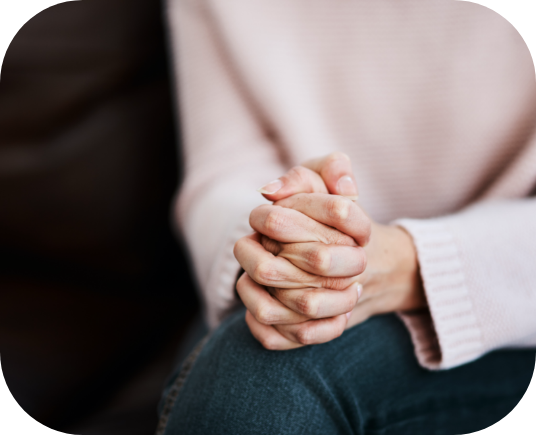

Eating Disorders
What are they?
There are many different types of eating disorders. The list below is not conclusive.
Anorexia Nervosa
When people are coping with anorexia, they will usually severely restrict their food intake. They try to control their weight through restricting calories, exercising excessively, or misusing diet aids/laxatives. Even if the person loses weight, they could have a fear they are going to regain it or be preoccupied if they are actually overweight. Anorexia is not strictly about food. It is typically because the individual is trying to cope with emotional problems. Some of the signs someone could be coping with anorexia are: slender appearance, tiredness, light-headedness, thinning or unhealthy hair, yellowish pallor, low blood pressure, susceptibility to the cold, and more.
Bulimia Nervosa
Bulimia nervosa is characterized by binging and purging. It is a cycle of eating too much followed by purging. The purging can be done through taking laxatives, enemas, diuretics, or vomiting. The person will be preoccupied or have a distorted view of their weight/body image. You might notice the person repeatedly eating lots of food in one sitting. After the binging, the person might excessively exercise, restrict food, or fast. The individual might also have damage to their teeth, gums, or knuckles.
Orthorexia Nervosa
Eating healthy and taking care of one’s own body is important for wellness. Unfortunately, some people can become obsessed and preoccupied with healthy eating. It can turn into orthorexia. Orthorexia is an unhealthy obsession with healthy eating. Healthy eating is a good thing, right? So how can it be problematic?
The individual becomes preoccupied with the quality of their food. They compulsively think about their food and their dietary choices, have severe anxiety around food and their dietary rules, and impose severe restrictions upon themselves. This preoccupation can come with many disruptions to daily life. Due to the severe restrictions, the person may struggle psychologically, medically, and socially. One of the key pieces of orthorexia is the disruption to the person’s life.
Binge Eating Disorder
Binge eating disorder (BED) is a very common eating disorder. While we may eat too much on occasion, binge eating disorder is often coupled with emotional eating and shame/guilt after the binging. In addition, BED is also characterized by increased frequency and feelings of loss of control. The person may also not like to eat in front of people due to embarrassment and often eat when they are not hungry.
Myths / Facts Section
FACT – Being “skinny” does not mean a person is necessarily healthy.
Society places value on slender figures. The current body standards are measured by often unrealistic body standards, but these beauty standards do not necessarily reflect health and wellness. The high value society has placed on being slender has become skewed with being healthy. People can be skinny and have a myriad of illnesses and diseases, as well. Society is just blinded by its current body standards. People who are overweight are at a higher risk of health issues, but that is not the only contributing factor.
FACT – Weight is influenced by many different factors.
If a person is overweight, there are many contributing factors. There is often discrimination against people who have extra weight because society values thinness and associates it with ambition, health, and wellness. People assume those who have extra weight are lazy and do not take care of themselves. Weight is influenced by many different factors, such as genetics, medication, health concerns/issues, activity level, and diet. Therefore, being overweight does not mean the person has binge eating disorder.
FACT – Fad diets can be extremely harmful and are not rooted in proper nutrition.
Fads diets seem like an enticing way to lose weight quickly. They promise a shortchange with amazing results. They often cut out a specific group of food which can result in not getting necessary nutrients. In addition to not being a healthy option to lose weight, fad diets do not help a person develop better eating habits. Once a person has lost weight and quits the fad diet, they will often gain it back.
FACT – Counting calories is misguided and not all calories are the same.
Weight loss has been guided for years by counting calories. It seems like a logical way to lose or maintain weight. Counting calories is outdated. While it may seem like a good way to manage weight, it neglects the fact calories are not the same. Consider 100 calories of carrots and fresh hummus versus 100 calories of deep-fried chicken wings. They will not contain the same amount/types of nutrients, fats, and minerals. The calories will be derived from different types of energies. More successful ways to manage health include food quality (whole foods, lean meat, vegetables, and fruits), exercise, sleeping well, manage stress levels, and consulting a professional/doctor (for help losing weight and consultation about medications/conditions which could cause weight gain).
FACT – Eating disorders are not something a person outgrows. They need professional help and intervention.
Eating disorders are very complex. If they are left untreated, it can be dangerous. If an eating disorder is treated early, there is a greater chance the person will recover. It can be scary to address an eating disorder, but it is necessary. Not addressing it can have dangerous consequences. Relying on a person growing out of an eating disorder or not talking about it perpetuates the stigma and shame surrounding it.
FACT – Not everyone has had or has an eating disorder.
Eating disorders impact approximately 1 million Canadians.
FACT – Eating disorders are very harmful and can result in death.
Eating disorders have harmful effects. Disordered eating impacts many body systems, including cardiovascular, gastrointestinal, neurological, and endocrine. When someone is not eating enough calories, their body starts to break itself down for fuel. This breakdown weakens the system and makes the person more susceptible to other health issues. If someone is purging, this reduces the nutrients, fluids, and electrolytes the person is absorbing. Purging also comes with damage to the gastrointestinal tract, including eroded teeth/esophagus, stomach pain/rupture, constipation, intestinal obstructions, and more. If someone has been binge eating, this can result in added stress to the body system.
Eating disorders are detrimental to the body. It is not a healthy way to lose weight. It can result in death as the damage to the body can be very severe.
FACT – Children can be preoccupied with their weight and develop eating disorders, too.
Research has found that children as young as 3 can have issues with body image and how they see themselves. Parents and guardians play an important role in promoting positive self-esteem and body image. They can help cultivate healthy body image. It is important to develop this foundation of acceptance to help combat the negative messages perpetuated by the media.
FACT – Eating disorders are not gendered. They impact all genders.
Eating disorders can impact anyone regardless of age, employment status, gender, sexual orientation, ethnicity, relationship status, or socio-economic background. Statistically, females are impacted 10 times more frequently than males. This does not undermine the fact there are males who have an eating disorder. Some studies suggest 10-15% of individuals with anorexia or bulimia are male. People who identify as 2SLGBTQ+ are at a higher risk of developing an eating disorder.


What could cause someone to have an eating disorder?
This is a challenging question to answer. There is no simple answer. The weight-loss industry has been benefiting from people feeling inadequate, insecure, and awful about their body image. This shift has created an environment which fosters eating disorders or disordered eating. In addition to the societal/media influences of eating disorders, other influences can be family dynamics, self-worth, and life stressors.
What Does It Look Like?
There are many different signs of eating disorders.
Anorexia Nervosa
Signs of anorexia could include:
- Being underweight
- Fixating on weight
- Body dysmorphia (feeling like they are overweight when they are not)
- Ignoring the seriousness of their weight
- Low self-esteem or their self-esteem is dependent on their weight
- Preoccupied with food, dieting, and body image
- Limiting how much they eat
- Moving their food around their plate to make it look like they are eating or taking small bites
- Yellow skin
- Irregular periods
- Problems with relationships
- Digestive problems
- Passing out
- Avoiding mealtimes
- Tiredness
- Withdrawal from relationships
- Exercising excessively
Bulimia Nervosa
Signs of bulimia could include:
- Fear of weight gain
- Thinking about weight and body image
- Repeated binging (eating large amounts of food in one sitting)
- Feelings of loss of control while eating
- Vomiting or exercising after binging/going to the bathroom right after eating
- Using laxatives, diuretics, or enemas after eating
- Restricting food intake or fasting followed by binging
- Calloused knuckles
- Eroded teeth
- Digestive issues
- Using weight loss products
Orthorexia Nervosa
Signs of orthorexia could include:
- Very concerned with the ingredients of food and the nutritional facts
- Concerned about the quality of ingredients
- Avoiding certain food groups
- Avoiding foods which are not healthy or “pure”
- Concerned with what other people are eating
- Thinking about the food at upcoming events
- Upset when “healthy” or “safe” foods are not available
- Follows healthy lifestyle blogs and social media accounts
- May, or may not be concerned with body image
Binge Eating Disorder
Signs of binge eating disorder could include:
- Frequently eating a lot of food in short periods of time
- Preoccupied with food
- Shame or guilt about eating/behaviour
- Eating when not hungry
- Eating alone to hide the shame or embarrassment
- Eating until uncomfortably full
- Eating quickly
- Frequently dieting with little results
Remember, people with eating disorders might not gain or lose weight. They could look like they have a “healthy” weight.

What To Do if You are Struggling With an Eating Disorder?
Most people struggle with self-worth and body image at some point in their lives. If you feel like your perception of your body/weight/size is unhealthy, you deserve to feel good about yourself. You deserve help.
First, identify that you are not doing well. It is not an easy thing to admit. Just remember, we cannot be tiptop all the time. It is okay not to be okay. It is about seeking help.
Second, talk to someone. Seek help with someone you trust whether a loved one, doctor, or a mental health professional. You deserve to feel better. It is important to take care of yourself and feel better. If you are having a hard time dealing with it, it is important to reach out for help. Talk to someone you trust about your struggles. There is no shame in asking for help. Asking for help is a great sign of strength.
Third, practice self-care. Make healthy choices to support your mental health. Take some time for you to feel better, to unwind, and to take care of yourself.
In addition to seeking professional help and reaching out, there are many things you can do to support your mental health. Check out the wellness tips below or the wellness sessions.
You deserve to feel happy and healthy. You’ve got this!
How to Help Someone Who Tells You They are Struggling?
When a loved one tells you they are struggling, it can be terrifying, and it can be hard to know what to do/say. It is easy to become caught up in emotions. Many people fear saying the wrong thing. We often want to try to fix our loved one’s problem or counsel them, but that is not your job. Your main job is to connect your loved one to help.
The following are some guidelines as to what to do when your loved one tells you they are struggling and how to handle those difficult conversations. This is not to counsel the person. This is to get the person connected with a helping professional. Please remember the conversation will not be linear like on the page. These are guidelines of somethings to consider.
The person is telling you something scary and personal to them. This is terrifying for both of you. Take a moment to gather yourself and take a deep breath. Remember… this is about them and their experience. When we care about someone and they tell us about their struggles, we sometimes react with what seems like anger. This is often an outward display of fear which comes across as anger. This can make it difficult for the person to open up to you.
Take a moment to recognize your own biases or judgements about mental health issues. You are entitled to your opinion, but remember this conversation is about your loved one. It is about their emotions, experiences, and perception. It is all valid and real for them. If you are going to have the conversation, place your judgements or preconceived notions aside to allow for understanding and compassion.
Validate, Encourage, Empower, Refer. (This is not counselling the person. It is connecting them with help.)
Validate – Validating is so important. It is letting the person know what they are feeling is okay. It is acknowledging their emotions as understandable.
For example:
- Yeah, that would be frustrating.
- I am sorry that happened to you.
- It is understandable you feel that way. I would feel that way, too.
- I believe you.
- From what you are saying, I am hearing you are…because of… Is that correct?
Encourage – This is letting the person know they did a good thing by telling you. Talking about mental health struggles can be very challenging. Let them know they are doing the right thing by telling you.
For example:
- Thank you telling me. That must have been challenging.
- You did the right thing by telling me.
- I am here for you.
Empower – Struggling with mental health issues can be overwhelming, so it is important to let the person know there is help and they can feel better.
For example:
- I know things seem really overwhelming, but there are resources and people to help.
- Let’s find some things which can help you feel better.
- You deserve to feel happy! We will find a way to get there.
Refer – Connect the person with help. They deserve to feel happy and healthy again. There are resources to help them. Your loved one needs to get help. This is not something you can deal with without professional help. Help the person think of someone they trust/who they would like to talk to about their challenges. Everyone connects with different types of help. Give your loved one options, like a doctor, individual counselling, group counselling, or an elder. You can also offer them some helplines they can call when they are struggling, too.
For example:
- Here are some phone numbers you can call when you feel like you need someone to talk to.
- Let’s look up some resources and see what you like best.
- There are many options of people you can talk to. We could talk to the doctor, find a counsellor, or elder. What would you be most comfortable with?
Give the person the time and consideration you would like if you were struggling. Be the person you would like helping you in this situation. Give them your full attention. They deserve it. Listening will also help you know what the person is trying to tell you. While you are listening, be understanding and compassionate. Give them the space to talk.
- Help the person think of who to tell and support them in seeking help. The youth needs to get help. You are obligated to connect the youth with professional help. Refer the youth to professional help like school counsellor, family liaison worker, or an elder. You can also offer them some helplines they can call when they are struggling, too.
- Do not ignore it. Having someone disclose mental health issues can be very challenging. Because it is scary, we sometimes want to ignore it, but you have a duty to report to connect the youth to help.
- Get help for you, too. Talking to a youth who is struggling is challenging. Talk to someone about it to help cope with the stress of the situation. Practice self-care. Do something you enjoy. For self-care ideas, visit the self-care section here.
Sometimes, people are not ready to talk to you. That is okay. It is their choice. Simply let them know you are there to talk if they need someone and give them resources.
How to Talk to Someone About Their Mental Health?
If you have a feeling something is going on, have a conversation with the person if you feel comfortable talking to them. (If you do not feel comfortable, that is okay. You just need to tell someone who will have the conversation with them and connect them with help).
The following are some guidelines of what to do if you suspect someone is suicidal or not doing well. This is not to counsel the person. This is to get the person connected with a counselor, doctor, or another professional. Please remember the conversation will not be linear like on the page. These are guidelines of some things to consider.
Before You Have the Conversation
- Make sure you have time for it
- You are in a place the person will feel comfortable to talk to you
- Approach the situation with compassion
- Make sure you are willing to listen
- Remember you can initiate the conversation and let them know you are there, but it may take some time before they talk to you.
If you feel like something is going on with someone, there likely is something. Trust that gut instinct.
Open the conversation in a nonjudgemental and compassionate way. Start off by stating a change you have noticed. Use “I” statements so it does not feel like you are accusing them.
Example: “Hey, I have noticed you have been cancelling plans lately. How are you doing?” or “I heard you putting yourself down in class. What’s been going on?”
Validate, Encourage, Empower, Refer. (This is not counseling the person. It is connecting them with help.)
Give the person the time and consideration you would like if you were struggling. Be the person you would like helping you in this situation. Give them your full attention. They deserve it. Listening will also help you know what the person is trying to tell you. While you are listening, be understanding and compassionate.
- Do not ignore it. Having someone disclose mental health issues can be very challenging. Because it is scary, we sometimes want to ignore it, but you have a duty to report to connect the youth to help.
- Get help for you, too. Talking to a youth who is struggling is challenging. Talk to someone about it to help cope with the stress of the situation. Practice self-care. Do something you enjoy. For self-care ideas, visit the self-care section here.
Sometimes, people are not ready to talk to you. That is okay. It is their choice. Simply let them know you are there to talk if they need someone and give them resources.
The person may not be ready to talk to you, and that is okay. Let them know you are there to talk whenever they are ready. Offer them helplines for support.
Follow-Up Support for Someone With an Eating Disorder
- Model healthy behaviour
- Be aware of your language (try to use positive language)
- Talk about the unrealistic portrayals in media/on social media
- Be open about the effects of puberty
- Promote positive eating habits and relationships with food
- Promote health exercise and activities
- Encourage positive friendships and relationships
- Celebrate a job well done and achievements
Things to Avoid
- Making fun of people’s weight
- Judging the individual
- Counselling the individual
Tips for Wellness

- Seek help when you feel triggered
- Follow body positive/neutral social media accounts
- Be aware of the type of content (social media) you are consuming
- Foster friendships/relationships which are healthy
- Do things that support and encourage positive self-worth
- Have fun
- Practice healthy boundaries
- Utilize positive affirmations
For more information or ideas for wellness, check out the wellness sessions.
Further Resources
Adult Obesity Causes & Consequences | Overweight & Obesity | CDC\
Anorexia nervosa – Symptoms and causes – Mayo Clinic
Binge-eating disorder – Symptoms and causes – Mayo Clinic
Body image in childhood | Mental Health Foundation
Body Image Issues (Children and Teens) | familydoctor.org
Bulimia nervosa – Symptoms and causes – Mayo Clinic
Bulimia nervosa – Symptoms and causes – Mayo Clinic
Causes of Eating Disorders (gruberpeplab.com)
Compulsive Overeating vs. Binge Eating Disorder (healthline.com)
Eating Disorder Statistics & Research | Learn | NEDA (nationaleatingdisorders.org)
Eating Disorders (for Parents) – Nemours Kidshealth
Eating Disorders in Canada – NIED
Eating Disorders in LGBTQ+ Populations | National Eating Disorders Association
Male Eating Disorders: A Snapshot of Statistics and Their Implications (eatingdisorderhope.com)
Orthorexia | National Eating Disorders Association
Orthorexia: When Healthy Eating Becomes a Disorder (healthline.com)
Section D – Eating disorders (statcan.gc.ca)
Stop counting calories – Harvard Health
The Facts – Eating Disorder Support Network of Alberta (edsna.ca)
If you would like to speak to someone about mental health issues, the Alberta Health Services Mental Health Help Line is available 24/7, offering information and referrals on any aspect of mental health.
Call toll-free: 1-877-303-2642
Trending Topics
Depression
Depression What Is It? Depression is a mood disorder which means it impacts how a person is feeling. It can cause a person to feel
Accidental Overdose
Accidental Overdose What Is it? An overdose is what happens to someone’s body when they take too much of a substance or too many substances.
Online Relationships
Online Relationships Online can be fun! There are games, music, and videos. We can talk to friends and family online. Tips for Being Safe Online:
Online Relationships
Online Relationships Online can be fun! There are games, music, and videos. We can talk to friends and family online. Tips for Being Safe Online:

